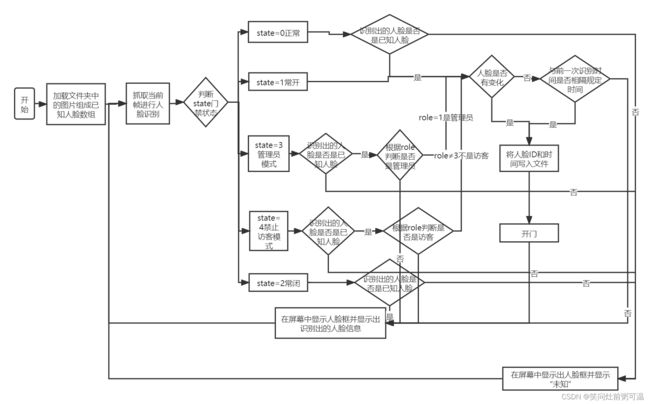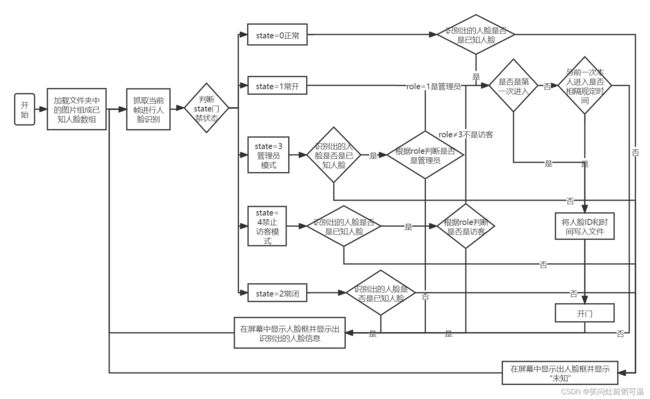笔记(二)face_recognition人脸识别代码分析
一、逻辑分析
1、逻辑一:
门禁状态state=0(正常)1(常开)2(常闭)3(仅管理员模式)4(禁止访客开门)
人员身份role=1(Admin管理员)2(User用户)3(Guest访客)
不允许一个人在一分钟内连续开门
2、逻辑二:
门禁状态state=0(正常)1(常开)2(常闭)3(仅管理员模式)4(禁止访客开门)
人员身份role=1(Admin管理员)2(User用户)3(Guest访客)
不允许一个人在五分钟内连续开门
二、代码块分析:
1.加载文件夹中的图片:
def scan_known_people(known_people_folder):
for file in image_files_in_folder(known_people_folder):
d = os.path.basename(file)
basename = os.path.splitext(d)[0]
if basename in known_face_names:
break
#print(d)#图片名加后缀
#print(basename)#图片名
img = face_recognition.load_image_file(file)
encodings = face_recognition.face_encodings(img)
known_face_names.append(basename)#任务名称的集合
known_face_encodings.append(encodings[0])#已知人脸的编码集合
return known_face_names, known_face_encodings2. 后续在显示过程中发现人脸识别后不能正确显示汉字,然后就加了下面这个函数,后续显示的时候直接调用就行
def cv2ImgAddText(img,text,left,top,textColor,textSize):
if(isinstance(img,np.ndarray)):
img=Image.fromarray(cv2.cvtColor(img,cv2.COLOR_BGR2RGB))
draw =ImageDraw.Draw(img)
ttf="/usr/share/fonts/opentype/noto/NotoSansCJK-Bold.ttc" #linux中的中文字体格式一般在/usr/share/fonts/opentype/noto下
fontStyle=ImageFont.truetype(
ttf,textSize,encoding="utf-8")
draw.text((left,top),text,textColor,font=fontStyle)
return cv2.cvtColor(np.asarray(img),cv2.COLOR_RGB2BGR)3.门禁状态state=0正常时,识别出已知人脸则将人脸信息和时间写入文件并开门,否则关门
def rolezero(facename,name):#正常
start = time.time()
namestart = facename
timenow = int(round(start*1000))
namenum = re.sub("\D","",name)#只传id
#识别出的人脸已知时保存数据
if(namenum):
doorState = "open"
nameandtime = {"name":namenum,"timestamp":timenow}
with open("/home/simon/mqtt/"+"FaceAndTime.json","a+") as p:
p.write(json.dumps(nameandtime)+"\n")
else:
doorState = "close"
return doorState4.门禁状态state=1常开时,识别出已知人脸则将人脸信息和时间存入文档,若识别出未知人脸则将人脸id设为0再与时间一同存入文件,门设为开
def roleone(facename,name):#常开
start = time.time()
namestart = facename
timenow = int(round(start*1000))
namenum = re.sub("\D","",name)#只传id
#识别出的人脸已知时保存数据
if(namenum):namenum = namenum
else:namenum = 0#识别出未知传送0
nameandtime = {"name":namenum,"timestamp":timenow}
with open("/home/simon/mqtt/"+"FaceAndTime.json","a+") as p:
p.write(json.dumps(nameandtime)+"\n")
return doorState5.门禁状态state=3仅管理员可开门时,判断识别出的人脸是否是管理员,若是则存入信息同时开门,若不是则关门
def rolethree(facename,name,c,b):#仅管理员可开门
start = time.time()
namestart = facename
timenow = int(round(start*1000))
namenum = re.sub("\D","",name)#只传id
#识别出的人脸已知时保存数据
if(namenum):
#循环userid的数组确定对应的role
key = len(c)-1
while(key>=0):
if(c[key]==namenum):
idrole = b[key]
break
key =key-1
if(idrole == 1):
nameandtime = {"name":namenum,"timestamp":timenow}
with open("/home/simon/mqtt/"+"FaceAndTime.json","a+") as p:
p.write(json.dumps(nameandtime)+"\n")
doorState = "open"
else:doorState = "close"
else:doorState = "close"
return doorState6.门禁状态state=4禁止访客访问状态时,若识别出的人脸已知且不是访客则存入信息且开门,若是则关门
def rolefour(facename,name,c,b):
start = time.time()
namestart = facename
timenow = int(round(start*1000))
namenum = re.sub("\D","",name)#只传id
#识别出的人脸已知时保存数据
if(namenum):
#循环userid的数组确定对应的role
key = len(c)-1
while(key>=0):
if(c[key]==namenum):
idrole = b[key]
break
key =key-1
if(idrole == 1 or 2):
nameandtime = {"name":namenum,"timestamp":timenow}
with open("/home/simon/mqtt/"+"FaceAndTime.json","a+") as p:
p.write(json.dumps(nameandtime)+"\n")
doorState = "open"
else:doorState = "close"
else:doorState = "close"
return doorState三、完整代码
逻辑一的代码:
import face_recognition
import cv2
import numpy as np
import os
import os.path
import itertools
import multiprocessing
from PIL import Image,ImageDraw,ImageFont
from face_recognition.face_recognition_cli import image_files_in_folder
import time
import datetime
import re
import face_recognition.api as face_recognition
import sys
import json
# 初始化一些变量
face_locations = []
face_encodings = []
face_names = []
known_people_folder = r'/home/simon/mqtt/picture'
known_face_names = []
known_face_encodings = []
b = []#role:1(Admin管理员)2(User用户)3(Guest访客)
c = []#userid
doorState = "close"#门的状态
idrole = 0#初始化由userid查找出的对应role
with open("/home/simon/mqtt/"+"shadow.ini","r") as mj:
mess = mj.read()
mess_parsed = json.loads(mess)
state_f = mess_parsed['payload']['state']['reported']['state']
state = int(state_f) #门禁状态state=0(正常)1(常开)2(常闭)3(仅管理员模式)4(禁止访客开门)
facelist = mess_parsed['payload']['state']['reported']['faceList']
for i in facelist:
role = i['role']
userid = i['userId']
b.append(int(role))
c.append(int(userid))#将role和userid对应存起来
#加载文件夹中的图片
def scan_known_people(known_people_folder):
for file in image_files_in_folder(known_people_folder):
d = os.path.basename(file)
basename = os.path.splitext(d)[0]
if basename in known_face_names:
break
#print(d)#图片名加后缀
#print(basename)#图片名
img = face_recognition.load_image_file(file)
encodings = face_recognition.face_encodings(img)
known_face_names.append(basename)#任务名称的集合
known_face_encodings.append(encodings[0])#已知人脸的编码集合
return known_face_names, known_face_encodings
def cv2ImgAddText(img,text,left,top,textColor,textSize):
if(isinstance(img,np.ndarray)):
img=Image.fromarray(cv2.cvtColor(img,cv2.COLOR_BGR2RGB))
draw =ImageDraw.Draw(img)
ttf="/usr/share/fonts/opentype/noto/NotoSansCJK-Bold.ttc" #linux中的中文字体格式一般在/usr/share/fonts/opentype/noto下
fontStyle=ImageFont.truetype(
ttf,textSize,encoding="utf-8")
draw.text((left,top),text,textColor,font=fontStyle)
return cv2.cvtColor(np.asarray(img),cv2.COLOR_RGB2BGR)
def rolezero(facename,name):#正常
start = time.time()
namestart = facename
timenow = int(round(start*1000))
namenum = re.sub("\D","",name)#只传id
#识别出的人脸已知时保存数据
if(namenum):
doorState = "open"
nameandtime = {"name":namenum,"timestamp":timenow}
with open("/home/simon/mqtt/"+"FaceAndTime.json","a+") as p:
p.write(json.dumps(nameandtime)+"\n")
else:
doorState = "close"
return doorState
def roleone(facename,name):#常开
start = time.time()
namestart = facename
timenow = int(round(start*1000))
namenum = re.sub("\D","",name)#只传id
#识别出的人脸已知时保存数据
if(namenum):namenum = namenum
else:namenum = 0#识别出未知传送0
nameandtime = {"name":namenum,"timestamp":timenow}
with open("/home/simon/mqtt/"+"FaceAndTime.json","a+") as p:
p.write(json.dumps(nameandtime)+"\n")
return doorState
def rolethree(facename,name,c,b):#仅管理员可开门
start = time.time()
namestart = facename
timenow = int(round(start*1000))
namenum = re.sub("\D","",name)#只传id
#识别出的人脸已知时保存数据
if(namenum):
#循环userid的数组确定对应的role
key = len(c)-1
while(key>=0):
if(c[key]==namenum):
idrole = b[key]
break
key =key-1
if(idrole == 1):
nameandtime = {"name":namenum,"timestamp":timenow}
with open("/home/simon/mqtt/"+"FaceAndTime.json","a+") as p:
p.write(json.dumps(nameandtime)+"\n")
doorState = "open"
else:doorState = "close"
else:doorState = "close"
return doorState
def rolefour(facename,name,c,b):
start = time.time()
namestart = facename
timenow = int(round(start*1000))
namenum = re.sub("\D","",name)#只传id
#识别出的人脸已知时保存数据
if(namenum):
#循环userid的数组确定对应的role
key = len(c)-1
while(key>=0):
if(c[key]==namenum):
idrole = b[key]
break
key =key-1
if(idrole == 1 or 2):
nameandtime = {"name":namenum,"timestamp":timenow}
with open("/home/simon/mqtt/"+"FaceAndTime.json","a+") as p:
p.write(json.dumps(nameandtime)+"\n")
doorState = "open"
else:doorState = "close"
else:doorState = "close"
return doorState
def face():
#获取对网络摄像头 #0 的引用(默认)
video_capture = cv2.VideoCapture(0)
global idrole
namestart = "未知"
start = time.time()
process_this_frame = True
print("state:")
print(state)
while True:
ret, frame = video_capture.read()# 抓取一帧视频
small_frame = cv2.resize(frame, (0, 0), fx=0.25, fy=0.25)# 将视频帧调整为 1/4 大小以加快人脸识别处理
rgb_small_frame = small_frame[:, :, ::-1] # 将图像从 BGR 颜色(OpenCV 使用的)转换为 RGB 颜色(face_recognition 使用的)
# 只处理每隔一帧的视频以节省时间
known_face_names, known_face_encodings = scan_known_people(known_people_folder)#加载文件夹中的图片
if process_this_frame:
# 查找当前视频帧中的所有人脸和人脸编码/根据encoding来判断是不是同一个人,是就输出true,不是为false
face_locations = face_recognition.face_locations(rgb_small_frame)#获得所有人脸位置
if face_locations:
face_encodings = face_recognition.face_encodings(rgb_small_frame, face_locations)#获得人脸特征值
face_names = []#存储出现在画面中人脸的名字
for face_encoding in face_encodings:
# 查看人脸是否与已知人脸匹配/默认为unknown
matches = face_recognition.compare_faces(known_face_encodings, face_encoding)
facename = "未知"
name = facename.encode("utf-8").decode("utf-8") #转为汉字
end = time.time()
# 如果在 known_face_encodings 中找到匹配,则使用与新人脸距离最小的已知人脸
face_distances = face_recognition.face_distance(known_face_encodings, face_encoding)
best_match_index = np.argmin(face_distances)
if matches[best_match_index]:
facename = known_face_names[best_match_index]
name = facename.encode("utf-8").decode("utf-8") #转为汉字
end = time.time()
face_names.append(facename)
now_time=datetime.datetime.now()
nowtime = datetime.datetime.strftime(now_time,'%Y-%m-%d %H:%M:%S')
#根据state来判断门禁模式
if(state==0):#正常
#识别出的人脸有变化
if (facename != namestart):
doorState = rolezero(facename,name)
#识别出的人脸没有变化时,不会连续发送,至少要过60秒
elif((end-start)>=60):
doorState = rolezero(facename,name)
else:doorState = "close"
if(state==1):#常开
doorState = "open"
if (facename != namestart):
doorState = roleone(facename,name)
#识别出的人脸没有变化时,不会连续发送,至少要过60秒
elif((end-start)>=60):
doorState = roleone(facename,name)
if(state==2):#常闭
doorState = "close"
if(state==3):#仅管理员可开门
#识别出的人脸有变化
if (facename != namestart):
doorState = rolethree(facename,name,c,b)
#识别出的人脸没有变化时,不会连续发送,至少要过60秒
elif((end-start)>=60):
doorState = rolethree(facename,name,c,b)
else:doorState = "close"
if(state==4):#禁止访客开门
#识别出的人脸有变化
if (facename != namestart):
doorState = rolefour(facename,name,c,b)
#识别出的人脸没有变化时,不会连续发送,至少要过60秒
elif((end-start)>=60):
doorState = rolefour(facename,name,c,b)
else:doorState = "close"
# 显示结果
for (top, right, bottom, left), facename in zip(face_locations, face_names):
# 缩放人脸位置,因为我们检测到的帧被缩放到 1/4 大小
top *= 4
right *= 4
bottom *= 4
left *= 4
cv2.rectangle(frame, (left, top), (right, bottom), (0, 0, 255), 2)# 在脸部周围画一个框
# 在人脸下方画一个带有名字的标签
cv2.rectangle(frame, (left, bottom - 35), (right, bottom), (0, 0, 255), cv2.FILLED)
if(doorState=="open"):
nameAndtime = name + ' ' + nowtime + ' ' + "door:" + doorState
else:
nameAndtime = name + ' ' + nowtime + ' '
#print(name)
img = cv2ImgAddText(frame, nameAndtime, (left + 6), (bottom - 30), (255, 255, 255), 20)#调用的函数
cv2.imshow('Video', img)# 显示结果图像
else:
cv2.imshow("Video",frame)
process_this_frame = not process_this_frame#不知道什么作用,感觉有点防抖动的意思
if cv2.waitKey(1) & 0xFF == ord('q'):# 按键盘上的“q”退出!
break
# 释放网络摄像头的句柄
video_capture.release()
cv2.destroyAllWindows()
if __name__=="__main__":
face()
逻辑二的代码:
import face_recognition
import cv2
import numpy as np
import os
import os.path
import itertools
import multiprocessing
from PIL import Image,ImageDraw,ImageFont
from face_recognition.face_recognition_cli import image_files_in_folder
import time
import datetime
import re
import face_recognition.api as face_recognition
import sys
import json
# 初始化一些变量
face_locations = []
face_encodings = []
face_names = []
known_people_folder = r'/home/simon/mqtt/picture'
known_face_names = []
known_face_encodings = []
b = []#role:1(Admin管理员)2(User用户)3(Guest访客)
c = []#userid
t = []#存进门的时间戳
doorState = "close"#门的状态
idrole = 0#初始化由userid查找出的对应role
with open("/home/simon/mqtt/"+"shadow.ini","r") as mj:
mess = mj.read()
mess_parsed = json.loads(mess)
state_f = mess_parsed['payload']['state']['reported']['state']
state = int(state_f) #门禁状态state=0(正常)1(常开)2(常闭)3(仅管理员模式)4(禁止访客开门)
facelist = mess_parsed['payload']['state']['reported']['faceList']
start = time.time()
for i in facelist:
role = i['role']
userid = i['userId']
b.append(int(role))
c.append(int(userid))#将role和userid对应存起来
t.append(int(0))#将进门的时间戳和userid对应存起来,初始时间戳都设为int(0)
#加载文件夹中的图片
def scan_known_people(known_people_folder):
for file in image_files_in_folder(known_people_folder):
d = os.path.basename(file)#图片名加后缀
basename = os.path.splitext(d)[0]#图片名
if basename in known_face_names:
break
img = face_recognition.load_image_file(file)
encodings = face_recognition.face_encodings(img)
known_face_names.append(basename)#任务名称的集合
known_face_encodings.append(encodings[0])#已知人脸的编码集合
return known_face_names, known_face_encodings
def cv2ImgAddText(img,text,left,top,textColor,textSize):
if(isinstance(img,np.ndarray)):
img=Image.fromarray(cv2.cvtColor(img,cv2.COLOR_BGR2RGB))
draw =ImageDraw.Draw(img)
ttf="/usr/share/fonts/opentype/noto/NotoSansCJK-Bold.ttc" #linux中的中文字体格式一般在/usr/share/fonts/opentype/noto下
fontStyle=ImageFont.truetype(ttf,textSize,encoding="utf-8")
draw.text((left,top),text,textColor,font=fontStyle)
return cv2.cvtColor(np.asarray(img),cv2.COLOR_RGB2BGR)
def face():
#获取对网络摄像头 #0 的引用(默认)
video_capture = cv2.VideoCapture(0)
#global idrole
namestart = "未知"
start = time.time()
process_this_frame = True
shibie_frame = False#用来在屏幕上显示开门
print("state:")
print(state)
while True:
ret, frame = video_capture.read()# 抓取一帧视频
small_frame = cv2.resize(frame, (0, 0), fx=0.25, fy=0.25)# 将视频帧调整为 1/4 大小以加快人脸识别处理
rgb_small_frame = small_frame[:, :, ::-1] # 将图像从 BGR 颜色(OpenCV 使用的)转换为 RGB 颜色(face_recognition 使用的)
# 只处理每隔一帧的视频以节省时间
known_face_names, known_face_encodings = scan_known_people(known_people_folder)#加载文件夹中的图片
if process_this_frame:
# 查找当前视频帧中的所有人脸和人脸编码/根据encoding来判断是不是同一个人,是就输出true,不是为false
face_locations = face_recognition.face_locations(rgb_small_frame)#获得所有人脸位置
if face_locations:
face_encodings = face_recognition.face_encodings(rgb_small_frame, face_locations)#获得人脸特征值
face_names = []#存储出现在画面中人脸的名字
for face_encoding in face_encodings:
# 查看人脸是否与已知人脸匹配/默认为unknown
matches = face_recognition.compare_faces(known_face_encodings, face_encoding)
facename = "未知"
name = facename.encode("utf-8").decode("utf-8") #转为汉字
#end = time.time()
# 如果在 known_face_encodings 中找到匹配,则使用与新人脸距离最小的已知人脸
face_distances = face_recognition.face_distance(known_face_encodings, face_encoding)
best_match_index = np.argmin(face_distances)
if matches[best_match_index]:
facename = known_face_names[best_match_index]
name = facename.encode("utf-8").decode("utf-8") #转为汉字
#end = time.time()
face_names.append(facename)
now_time=datetime.datetime.now()
nowtime = datetime.datetime.strftime(now_time,'%Y-%m-%d %H:%M:%S')
if(state==0):#正常
now = time.time()
namestart = facename
timenow = int(round(now*1000))#ms级时间戳
namenum = re.sub("\D","",name)#只传id
#识别出的人脸已知时保存数据
if(namenum):
#循环userid的数组确定对应的时间戳
key1 = len(c)-1
while(key1>=0):
if(c[key1]==int(namenum)):
if(t[key1]==int(0)):#第一次进门
nameandtime = {"name":namenum,"timestamp":timenow}
with open("/home/simon/mqtt/"+"FaceAndTime.json","a+") as p:
p.write(json.dumps(nameandtime)+"\n")
doorState = "open"
shibie_frame = True
t[key1] = timenow#更新时间戳
else:#不是第一次进门
itime = t[key1]
#判断当前人员与前一次进门是否相差规定时间
if((timenow-itime)>=360000):#5分钟内不能重复识别#1秒相差1200
nameandtime = {"name":namenum,"timestamp":timenow}
with open("/home/simon/mqtt/"+"FaceAndTime.json","a+") as p:
p.write(json.dumps(nameandtime)+"\n")
doorState = "open"
shibie_frame = True
t[key1] = timenow#更新时间戳
else:
doorState = "close"
shibie_frame = False
break
key1 =key1-1
else:
doorState = "close"
shibie_frame = False
if(state==1):#常开
doorState = "open"
start = time.time()
namestart = facename
timenow = int(round(start*1000))
namenum = re.sub("\D","",name)#只传id
#识别出的人脸已知时保存数据
if(namenum):namenum = namenum
else:namenum = 0#识别出未知传送0
#循环userid的数组确定对应的时间戳
key1 = len(c)-1
while(key1>=0):
if(c[key1]==int(namenum)):
if(t[key1]==int(0)):#第一次进门
nameandtime = {"name":namenum,"timestamp":timenow}
with open("/home/simon/mqtt/"+"FaceAndTime.json","a+") as p:
p.write(json.dumps(nameandtime)+"\n")
doorState = "open"
shibie_frame = True
t[key1] = timenow#更新时间戳
else:#不是第一次进门
itime = t[key1]
#判断当前人员与前一次进门是否相差规定时间
if((timenow-itime)>=360000):
nameandtime = {"name":namenum,"timestamp":timenow}
with open("/home/simon/mqtt/"+"FaceAndTime.json","a+") as p:
p.write(json.dumps(nameandtime)+"\n")
doorState = "open"
shibie_frame = True
t[key1] = timenow#更新时间戳
else:shibie_frame = False
break
key1 =key1-1
if(state==2):#常闭
doorState = "close"
shibie_frame = False
if(state==3):#仅管理员可开门
start = time.time()
namestart = facename
timenow = int(round(start*1000))
namenum = re.sub("\D","",name)#只传id
#识别出的人脸已知时保存数据
if(namenum):
#循环userid的数组确定对应的role和时间戳
key1 = len(c)-1
while(key1>=0):
if(c[key1]==int(namenum)):
idrole = b[key1]
itime = t[key1]
if(idrole==int(1)):
if(itime==int(0)):#第一次进门
nameandtime = {"name":namenum,"timestamp":timenow}
with open("/home/simon/mqtt/"+"FaceAndTime.json","a+") as p:
p.write(json.dumps(nameandtime)+"\n")
doorState = "open"
shibie_frame = True
t[key1] = timenow#更新时间戳
else:#不是第一次进门
#判断当前人员与前一次进门是否相差规定时间
if((timenow-itime)>=360000):
nameandtime = {"name":namenum,"timestamp":timenow}
with open("/home/simon/mqtt/"+"FaceAndTime.json","a+") as p:
p.write(json.dumps(nameandtime)+"\n")
doorState = "open"
shibie_frame = True
t[key1] = timenow#更新时间戳
else:
doorState = "close"
shibie_frame = False
else:
doorState = "close"
shibie_frame = False
break
key1 =key1-1
else:
doorState = "close"
shibie_frame = False
if(state==4):#禁止访客开门
start = time.time()
namestart = facename
timenow = int(round(start*1000))
namenum = re.sub("\D","",name)#只传id
#识别出的人脸已知时保存数据
if(namenum):
#循环userid的数组确定对应的role
key1 = len(c)-1
while(key1>=0):
if(c[key1]==int(namenum)):
idrole = b[key1]
itime = t[key1]
if(idrole==int(1) or int(2)):
if(itime==int(0)):#第一次进门
nameandtime = {"name":namenum,"timestamp":timenow}
with open("/home/simon/mqtt/"+"FaceAndTime.json","a+") as p:
p.write(json.dumps(nameandtime)+"\n")
doorState = "open"
shibie_frame = True
t[key1] = timenow#更新时间戳
else:#不是第一次进门
#判断当前人员与前一次进门是否相差规定时间
if((timenow-itime)>=360000):
nameandtime = {"name":namenum,"timestamp":timenow}
with open("/home/simon/mqtt/"+"FaceAndTime.json","a+") as p:
p.write(json.dumps(nameandtime)+"\n")
doorState = "open"
shibie_frame = True
t[key1] = timenow#更新时间戳
else:
doorState = "close"
shibie_frame = False
else:
doorState = "close"
shibie_frame = False
break
key1 =key1-1
else:
doorState = "close"
shibie_frame = False
else:
doorState = "close"
shibie_frame = False
# 显示结果
for (top, right, bottom, left), facename in zip(face_locations, face_names):
# 缩放人脸位置,因为我们检测到的帧被缩放到 1/4 大小
top *= 4
right *= 4
bottom *= 4
left *= 4
cv2.rectangle(frame, (left, top), (right, bottom), (0, 0, 255), 2)# 在脸部周围画一个框
cv2.rectangle(frame, (left, bottom - 35), (right, bottom), (0, 0, 255), cv2.FILLED) # 在人脸下方画一个带有名字的标签
namec = ''.join(re.findall('[\u4e00-\u9fa5]',name))#只显示名字不显示id
nameAndtime = namec + ' ' + nowtime + ' '
img = cv2ImgAddText(frame, nameAndtime, (left + 6), (bottom - 30), (255, 255, 255), 20)#调用的函数
if(shibie_frame):
(H,W) = frame.shape[:2]
rec = (H,W)
width = 1000#框的大小
height = 150
(w,h) = (width,height)
(x,y) = (int((rec[1]-width)/2),int((rec[0]-height)/2))
cv2.rectangle(frame, (x, y), (x+w, y+h), (0, 255, 0), cv2.FILLED)
image1=cv2ImgAddText(frame,("欢迎"+namec+"!已开门!"),(int((rec[1]-width)/2)+100),int((rec[0]-height)/2),(0,0,255),100)
cv2.imshow('Video',image1)
else:
cv2.imshow('Video', img)# 显示结果图像
else:
cv2.imshow("Video",frame)
process_this_frame = not process_this_frame#不知道什么作用,感觉有点防抖动的意思
if cv2.waitKey(1) & 0xFF == ord('q'):# 按键盘上的“q”退出!
break
# 释放网络摄像头的句柄
video_capture.release()
cv2.destroyAllWindows()
if __name__=="__main__":
face()四、遇到的问题及知识点总结
1.编码:encode,把你认识的转为机器人认识的
解码:decode,把一堆机器人认识的解释为人能读懂的
2.在python中,通过import可以简化代码
例:import numpy---->data=numpy.ndarry
import numpy as np---->data=np.ndarray
3.os.path.splitext("文件路径") 可以分离文件名与拓展名
4.
with open("a.txt","w") as p:
p.write()
with open("a.txt","a") as p:
p.write()w:覆盖内容
a:新增内容
5.Question:TypeError: a bytes-like object is required,not 'str'
Solution:
#原代码
with open("/home/simon/mqtt/"+"shadow.ini","wb") as sd:
sd.write(msg.payload.decode('utf-8'))
#更改后的代码
with open("/home/simon/mqtt/"+"shadow.ini","w") as sd:
sd.write(msg.payload.decode('utf-8'))
将“wb”改为“w”即可解决这个问题,主要是with open存的格式问题
6.数组(list)转字符串(str)
#list内容:
meslist = [{'userId':2.0,'deadline':164096,'role':2.0},{'userId':3.0,'role':1.0}]
list内有数字,不能简单地用 ','.join(meslist) 会报错
正确方法:
strm = ",".join('%s'%id for id in meslist)
print(strm)
输出的strm内容:
{'userId':2.0,'deadline':164096,'role':2.0},{'userId':3.0,'role':1.0}
7.目标:将数组中所存的字符串的对应数据拿出来重新组成数组
原数组:meslist = [{'userId':2.0,'deadline':164096,'role':2.0},{'userId':3.0,'role':1.0}]
目标数组:a = [2,3]
#实现代码
a = [0]
for i in meslist:
userid = i['userId']
a.append(int(userid))8.成员操作符in<用来判断一个字符串中是否有某个量>
str = "string test string test"
find1 = "str"
find2 = "test"
print(find1 in str) #True
print(find2 not in str) #False此篇博客仅做为我此次任务的一个记录,后续还会继续努力。
注:人脸识别设备和mqtt服务器的连接以及传输的代码在下一篇博客中
以上仅是课设个人笔记,如有错误欢迎指正~

